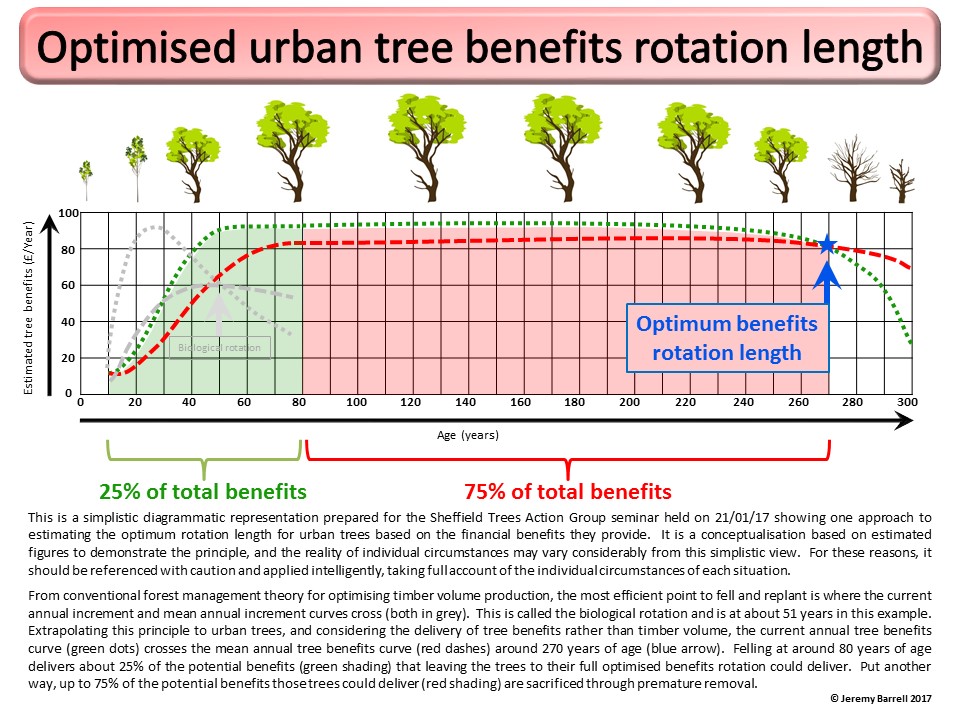Sheffield was widely hailed as one of Europe’s greenest cities, but it is rapidly gaining an international reputation as the place where they are felling street trees on an industrial scale. Local democracy seems to be unravelling before an international audience as the wishes of local communities are ignored and healthy trees with decades of life left in them are felled causing significant loss of tree benefits. It is a political problem and it will be for the politicians to find a solution, with issues way beyond the remit for tree experts to resolve. However, in the melee for the high ground, tree management principles are being misapplied as Sheffield City Council clamours to justify its actions, and that certainly is a matter where tree professionals can assert authority.
At the heart of the rhetoric is the contention that the trees are mature, with little useful life expectancy, and it is in the best interest of the community and good management, to fell and replace them immediately. Two technical pillars support that position; life expectancy, and the optimum felling point, or rotation length. Taking life expectancy first, I have seen a significant selection of the condemned trees and I assess that most of them have decades, if not centuries, of life left in them, so the justification of “they are at the end of their useful life” falls away under professional scrutiny. Of course, that is my opinion, and there will always be scope for disagreement, but the trees are there for all to see, so doubters can form their own opinion.
This leaves us with rotation length, and more specifically, what is the optimum point in time to fell street trees. While there is plenty of research on forestry rotation length, there is very little guidance for street trees, and thus this post. How can we as professional tree managers assist in deciding the optimum time to remove and replace street trees? Foresters grapple with this concept on a daily basis, with the principles of current annual increment (“CAI”) and mean annual increment (“MAI”) being the foundation for many decisions where optimising the timber volume is the priority. From research and practical experience, we know that the optimum time to fell is the age where the curves of CAI and MAI cross, but can this principle be reasonably transferred to urban tree management, where the product is tree benefits rather than timber volume?
Which reveals the heart of the problem; conventional street tree management decision making has been focused almost entirely on costs, with no balanced consideration of benefits. There are plenty of models identifying how much it costs to buy, plant and maintain a new tree through to removal, but very few factoring in the multiple benefits that trees provide. Accountants are exploiting this knowledge gap at the expense of communities, creating an urgent need for the tree profession to stand up and inject some balance into the decision-making process. Towards this end, I have worked up a draft conceptualisation of what an urban tree benefits model may look like (see attached figure). It reflects the concepts of CAI and MAI, with the optimum rotation length being where they cross. Conceptualising tree benefits is tricky for multiple reasons; primarily because most are difficult to reliably value, but also because some are linked to size, e.g. pollution buffering, water buffering, health and wellbeing, etc, while others are more related to age, e.g. ecology, heritage, etc. I accept that the precise form of the curves will vary with species, growing conditions, local benefit values, etc, but that aside, the primary question is whether this conceptualisation reasonably captures the principle.
With increasing instances of street trees being prematurely removed across the country based on costs rather than a balance of costs and benefits, this is becoming an increasingly important built environment management issue, which is why I would be grateful for feedback on any fundamental flaws that this CAI/MAI approach may have.

Disclaimer: The views and opinions expressed in this article are those of the author and do not necessarily reflect the views of the Institute of Chartered Foresters.






